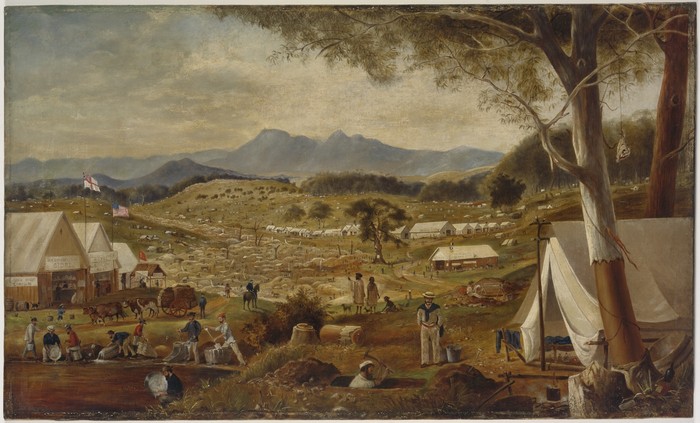Gold diggings, Ararat
c1858
Oil on canvas
Bequest of Sir William Dixson, 1929
DG 15
‘It is not only the diggers who make money at the Gold Fields. Carters, carpenters, storemen, wheelwrights, butchers, shoe-makers &c., usually in the long run make a fortune quicker than the diggers themselves, and certainly with less hard work or risk of life.’*
Artists also flocked to the diggings hoping to make their fortune. The British painter, writer and traveller Edward Roper visited Australia at least twice between1855 and the late 1880s. His scenes of the Australian bush and goldfields were especially popular among audiences in England, who were deeply curious about life in the colonies. As shown in the vivid detail in this view of Ararat, his paintings continue to provide a rich record of life on diggings and this extraordinary chapter in Australia’s history.
A great number of valuable pictures
‘Dear Sir, as
you are aware I have a number of valuable pictures packed away as I have no
room to display them … it would be a good thing if they were placed where those
interested could see them.’*
Library
benefactor Sir William Dixson had a particular passion for collecting pictures,
but storing them proved a challenge. Even though he lived in a large house, he
kept his extensive picture collection in an underground vault as the house was
filled with his vast library of books. In 1919 Dixson first offered his picture
collection to the State Library’s principal librarian. It took ten years for
the collection to be handed over, as the main condition in his bequest included
the construction of a new Sir William Dixson wing, including a gallery and
stack space to house his large collection.
Footnotes
*Letter from Sir William
Dixson to the State Library’s principal librarian, 1919
No joke
‘It is no
joke to get ill at the diggings; doctors make you pay for it. Their fees are –
for a consultation, at their own tent, ten shillings; for a visit out, from one
to ten pounds, according to time and distance. Many are regular quacks, and
these seem to flourish best. The principal illnesses are weakness of sight,
from the hot winds and sandy soil, and dysentery, which is often caused by the
badly-cooked food, bad water and want of vegetables.’*
Visitor to the goldfields Ellen Clancy, 1852–53
Footnotes
* From A lady's visit to the gold diggings of Australia in 1852–53, 1853,
p 93



 Back to list
Back to list